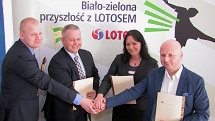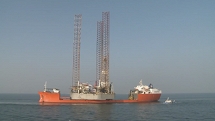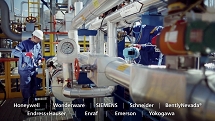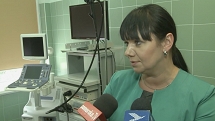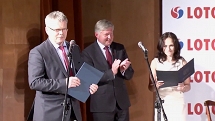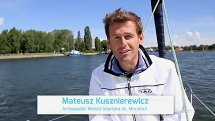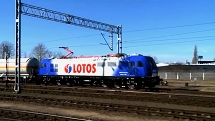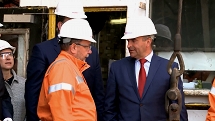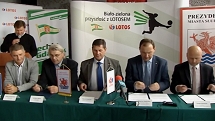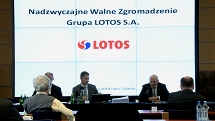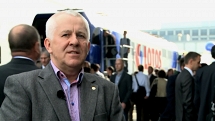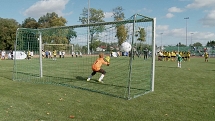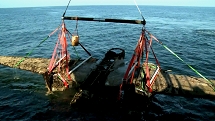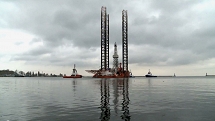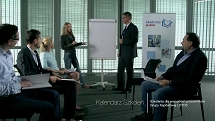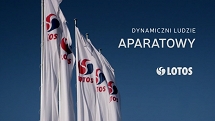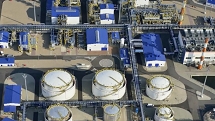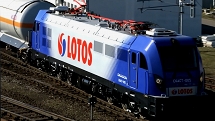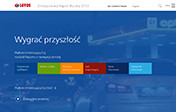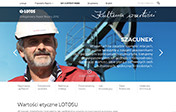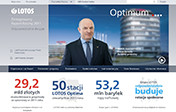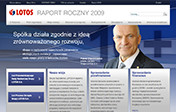-
Financial information
The past year ushered in a series of challenges for the companies in the fuel sector. The decisions made by us have demonstrated that we are able to take rapid steps to adapt to a demanding environment and ensure the desired profitability for our projects.
-
Segment performance
The segmental management model we have implemented enhances management efficiency, delivering cost and revenue synergies across the organization.
-
Letter from the Vice-President of the Board
2014 ushered in a series of challenges for the companies in the fuel sector. The decisions made by the LOTOS Group have demonstrated that we are able to take rapid steps to adapt to a demanding environment and ensure the desired profitability for our projects.
-
Business environment
The key factor that had a strong impact on both the global and Polish petroleum markets in 2014, with significant consequences for the LOTOS Group’s performance, was the price of crude oil, which also determined the price of petroleum products.
-
Strategic objectives
The LOTOS Group’s Strategy is designed to strengthen our position as a strong, innovative and efficient business which plays a major role in ensuring national energy security.
-
Business model
Our operations consist in crude oil production and processing, as well as wholesale and retail sale of petroleum products, among which are: fuels (unleaded gasoline, diesel oil and light fuel oil), heavy fuel oil, bitumens, aviation fuel, naphtha, propane-butane LPG and base oils.
-
Risk and opportunities
At the LOTOS Group, we identify a range of diverse risks, which may affect all areas of our business. The key risks in terms of their impact on our operations are the financial risks as well as risks affecting the exploration and production area. In the analysis of the risks, we also factor in issues related to sustainable development.
-
Key data 2014
With revenue of ca. PLN 28.5bn in 2014, we rank fourth in the group of 500 largest businesses in Poland.

Exploration and production segment
1. Exploration risks
Risks from estimating the resources and reserves of hydrocarbons discovered by exploration wells
Due to uncertainty involved in the evaluation of formation properties affecting the volume of resources, we provide three estimate cases for reserves (1P/2P/3P 1) and for undiscovered prospective resources (P10/P50/P90 2), in accordance with the SPE 2007 international classification framework.
It is possible that the presence of resources inferred from geological and seismic data is not confirmed after a well is drilled and the estimated resources will be smaller than expected. After a discovery is tested through successive wells, there is also a risk that its estimated resources will be reduced due to unfavourable changes in the formation properties. One of the methods of ongoing risk management in the estimation of reserves and resources is to identify and map the distribution of formation properties indicating the presence of hydrocarbon accumulations, i.e. area and thickness, porosity and hydrocarbon saturation. Estimates are also made after a new well is drilled on a prospect or after events occur that may affect the size of reserves.
Risk of drilling a dry well (without hydrocarbon flow)
In assessing the chance of success and discovery of a hydrocarbon accumulation, we use the PoS (probability of success) metric. PoS is calculated based on the assessment of the four factors listed above (area and thickness, porosity and hydrocarbon saturation), which are assigned probability on a scale of 0% – 100%. A multiple based on these factors is a measure of the probability of success. Another method of ongoing risk management is to perform geological analyses for an exploration well. For a production well, reservoir engineering analyses and depleted zone simulations are performed before a decision is made whether and where to drill a production well.
2. Technical and production risks
Risk of failure of production equipment and facilities due to their limited durability or improper operation
Should this risk materialise, it may result in financial losses due to production stoppages. To effectively manage this risk, we take a number of measures, including regular overhauls, repairs and measurements, regular internal inspections of the equipment, and supervision performed by certification and administrative bodies.
Risks from infrastructure operation
Risks of oil spill, sea collision, fire or blowout may cause environmental contamination, serious injury or death of an employee, downsizing or stoppage of production, as well as entail significant costs to remedy the resulting damage or pay fines. This risk is the function of the quality of E&P infrastructure operation, use of adequate technical solutions as well as staff’s and subcontractors’ awareness and skills, and so we take a number of measures to prevent such accidents from occurring.
3. Risks related to exploration and production projects
Risk of limited control of joint ventures
Since at least two partners are involved in joint venture projects, there is a risk that they will not be executed in accordance with the LOTOS Group’s expectations. We mitigate this risk by properly defining the acceptable conditions on which we can become involved in a project, and by vetting the other interest holders, their goals, motivation, financial standing, ownership structure and perception. Another important thing is to properly define the common interests, analyse the legal, tax and business regulations in a due diligence process, and study the provisions of partnership agreements to ensure our interests are secured. The risk is also minimised by devising an appropriate negotiation strategy at the time of entering into a new partnership and while it continues, as well as by ongoing monitoring of contractual provisions, evaluating and approving budgets and schedules, appointing committees, and recommending decisions to be made by the relevant governing bodies.
All of the activities listed above were carried out in 2014 on all licences held in Norway and Poland.
- Projects implemented jointly with partners include the Norwegian projects: Frigg Gamma Delta and Fulla, as well as joint application in the APA 2014 licensing round.
- An example of such a project on the Baltic Sea is the partnership with CalEnergy Resources in the development of the B4 and B6 gas fields.
In 2014, the cooperation in all of these projects ran smoothly, in line with the action plan prepared for each project.
Risk of involving capital in unsatisfactory projects
This risk is associated with the execution of partnership agreements and may result in financial losses. To counteract this risk, we take care to properly define goals and acceptable conditions on which Grupa LOTOS can participate in a project, and to select appropriate partners. For each project, we define the acceptable economic viability framework and implement proper analytic tools to assess the project. We set up multidisciplinary teams to estimate the economic, legal, tax and technical risks.
Risk of increased liabilities in relation to the YME project
Given the significance of the YME project and its impact on the our past performance, it is under special supervision, with a number of measures implemented to mitigate the attendant risks connected with additional unjustified costs. Currently, efforts are being made to sell the interests in the YME field. Two sub-projects have been defined – removal of the MOPU (Mobile Offshore Production Unit) from the field, and submission of a new YME field development plan to Norway’s Ministry of Petroleum and Energy to raise the value of the interests we intend to sell. To mitigate the risk related to the removal of the MOPU, an agreement was signed with Single Buoy Moorings Inc., the MOPU’s producer, under which it agreed to cover the costs of the unit’s removal from the field and paid compensation to the consortium members. Of the amount transferred to the YME project escrow account, USD 81.78m was attributable to LOTOS Norge. As at the date of this Report, the estimated cost of the MOPU removal did not exceed the funds held in the account. The planned completion of the MOPU removal activities is scheduled by the Operator for the end of Q3/the beginning of Q4 2015.
In 2014, we evaluated the quality of work performed by the operator in the YME field, helped to build an agreement between those partners that were not consortium operators in order to strengthen our position, engaged international advisers, and created the YME Task Force at LOTOS Norge to provide ongoing support to the project manager. We also held talks with the Norwegian authorities to clearly confirm our intention to continue operations on the Norwegian Continental Shelf. At the time of preparing this Report, there was no unanimous decision of the YME consortium members as to further steps to be taken in relation to the field. As proposed by the controlling group of interest holders, a plan is to be prepared by the end of 2015 for complete decommissioning of the field infrastructure, which may prevent recovery of the invested capital through the sale of interests in the option of field development. However, LOTOS Norge continues work on persuading the partners in the licence to further analyse the possible options for development of the field. The rationale for and amount of further capital expenditure on development of the YME field are the subject of thorough analyses and assessments of the risk involved.
4. Financial risk related to the upstream business
Macroeconomic risk
Risks related to macroeconomic factors were crucial for the functioning of the exploration and production segment in 2014. These included in particular a plunge in crude oil prices, resulting in deterioration of the economic parameters and profitability of investments in the upstream business, and affecting the availability and terms of external financing for such projects.
Currently, funding is being raised for a new large project in the segment, i.e. development of the B8 field in the Baltic Sea. On August 25th 2014, agreements were executed for the financing of the project with Polskie Inwestycje Rozwojowe, Bank Gospodarstwa Krajowego, and Bank Pekao S.A. The project is at the stage of fulfilling the conditions precedent to the disbursement of funding. Moreover, in Q4 2014 Grupa LOTOS raised approximately PLN 1bn through the issue of shares to finance its two key projects, including development of the B4/B6 gas fields.
1 1P reserves – proved reserves, having a 90% probability of being produced; 2P – proved and probable reserves, having a 50% probability of being produced; 3P – proved, probable and possible reserves, having a 10% probability of being produced.
2 P90 – volumes with a 90% certainty/probability of being produced, P50 – volumes with a 50% certainty/probability of being produced, P10 – volumes with a 10% certainty/probability of being produced.






